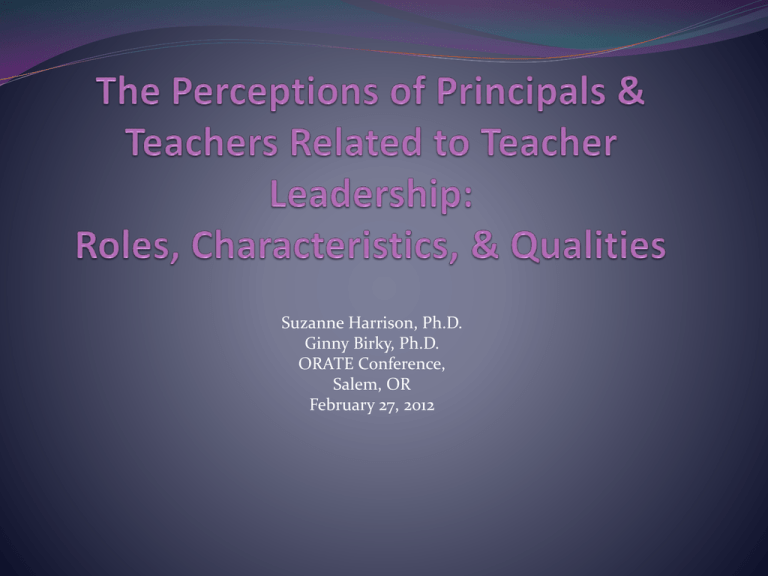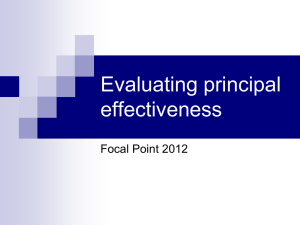Revisiting Teacher Leadership: Differences in Educator
advertisement

Suzanne Harrison, Ph.D. Ginny Birky, Ph.D. ORATE Conference, Salem, OR February 27, 2012 “The radical transformation toward teacher leadership is not an option; it is a necessity.” The Leadership Imperative (Reeves, 2008, p. 17) Introduction: Rationale 1. 1990’s: Teacher leadership had a significant impact on the concept of leadership in schools 2. Recent influences No Child Left Behind An era of accountability Educational reform Teacher voice in professional development 3. Current: Re-emergence with an even greater importance Purpose of the Study Discover perceptions of teachers and principals regarding teacher leadership. Research Question What are the perceptions of teachers and principals regarding teacher leadership? Definition of Teacher Leadership “Teacher leadership is the process by which teachers, individually or collectively, influence their colleagues, principals, and other members of the school communities to improve teaching and learning practices with the aim of increased student learning and achievement” (York-Barr & Duke, 2004, p. 2). Review of the Literature Importance of Teacher Leadership Teacher leadership is critical to the advancement of educational reform efforts in schools (Starratt, 1995). “Research has led many people to the conclusion that teachers need greater leadership opportunities if public education is to survive in any kind of meaningful way" (Wasley, 1991, p. 7). Teacher leaders keep a school “moving toward excellence” (Darensbourg, 2011, p. 68). "Teacher leaders remain the last best hope for significantly improving American education" (Pellicer & Anderson, as cited in Moller & Katzenmeyer, 1996, p. 82). Teacher-leader Relationship with Administrators Teacher leaders are seldom effective in their roles without the support and encouragement of their administrator. The principal’s style and characteristics influence change, school improvement, and student success (DeMoss, 2002; Glickman, 2002; Supovitz, 2000; Willmore & Thomas, 2001). High–performing schools that get the best results from the classroom are led by principals who blend strong instructional leadership with a collaborative style that involves teachers in school decisions (Sherman, 2000). Roles of Teacher Leaders Patterson and Patterson (2004) referred to formal and informal teacher leader roles. Formal teacher leaders Those given familiar titles such as department chair, curriculum coordinator, data coach, instructional specialist, and compensated either by additional salary or in exchange for a lighter teaching load Informal teacher leaders “Recognized by their peers and administrators as those staff members who are always volunteering to head new projects, mentoring and supporting other teachers, accepting responsibility for their own professional growth, introducing new ideas, and promoting the mission of the school" (Wasley, 1991, p. 112). Focus is more on the learning and improvement of school and student performance than on leading. Examples include: facilitator, advisor/mentor, peer observer, member of PLC, resource provider The work of teacher leaders greatly varied, but was usually specific to the context of the school (Boyd-Dimock and McGree, 1995). The most common roles played by teacher leaders were collaboration with peers, and communication with all members of their school community (Birky & Ward, 2001). The typical roles that teacher leaders perform are to: Plan, organize, and create Assist in the overall improvement of a school’s community and performance Collaborate with peers, parents, and school communities Continuously reflect on their work and the work their school is doing (Darensbourgh, 2011, p. 68). Characteristics and Qualities of a Teacher Leader According to Darensbourg (2011), teacher leaders: Are passionate, driven, and have expertise in instruction Engage in continuous inquiry, inform, persuade, mobilize, and energize others to do more with their communities Are willing to take risks and participate in shared decision making Stay current in the field Are often politically active and aware socially of issues pertaining to their profession and the students they work with (p. 68) Skills and Roles of Teacher Leaders Lieberman, Saxl, and Miles (1988) included the following skills and roles: Building trust and developing rapport Diagnosing organizational conditions Dealing with processes Building skills and confidence in others Being non-judgmental Modeling collegiality Enhancing teachers’ self-esteem Encouraging other teachers Continually learning Promoting a clear vision Taking initiative Persevering in the face of obstacles Analyzing and making program adjustments/improvements Building a team spirit Facilitating communication and reflection among the faculty Exercising patience Research Methods 1. Qualitative Study: Exploratory Narrative responses 2. Participants: 51 teachers & principals from K-12 public schools 12 principals 39 teachers 3. Convenience & purposive sampling to gather data from 4 different groups (Berg, 2007): Doctoral educational leadership class Two literacy workshops for secondary teachers Principals Instrument: Teacher Leadership Survey What does teacher leadership mean to you? What are the formal and informal roles of a teacher leader? What are the most important characteristics/traits of a teacher leader? Data Analysis Organized based by gender, position, and years of experience Coded Themes and patterns Graphic Organizer used for Data Teacher: Female Definition of TL: 0-5 yrs. Definition of TL: 6-15 yrs. Definition of TL: 16-over Position: 0-5 yrs. Position: 6-15 yrs. Position: 16-over yrs. Characteristics of TL.: 0-5 yrs. Characteristics of TL: 6-15 yrs. Characteristics of TL: 16-over yrs. Teacher: Male Principal: Female Principal: Male Perceptions about Teacher Leadership Definitions & Roles Definitions & Roles Characteristics & Qualities Characteristics & Qualities Gender --- Position --- Years of Experience Results of the Study Participant Similarities & Differences Gender (male, female) No apparent difference between female and male responses Years of experience (0-5 yrs., 6-15 yrs., 16 over yrs.) Minimal differences between years of experience and perceptions: Principals and teachers with less experience mentioned collaboration more frequently Position (teacher, principal) Some differences between teacher and principal perceptions: Teachers more frequently focused on the classroom; principals more often mentioned vision/mission. Teachers more often mentioned “soft skills” (caring, listening, supporting); principals more often mentioned “hard skills” (taking risks, leading). Principals discussed the role of teacher leaders in more depth than teachers did when they talked about the role. Principals mentioned more frequently the purpose/value of teacher leadership versus teachers who had a limited view of teacher leadership roles. More teachers referred to teacher leaders’ influence on the classroom and student learning than administrators who referred to teacher leaders’ influence on school. Four Emergent Themes Collaboration Teaching and Learning Managing the Work Interpersonal Relationships Theme: Collaboration Cooperate: share, explore, and work together Mentor: guide, advocate, empower, inspire, model “[Teacher leadership is] working in conjunction with the school leader, not separately or against. Being a TL sometimes requires a teacher to put his/her own personal view or preference aside and be willing to make decisions that are most beneficial to the whole” (P). “Teachers taking on the role of leading other teachers to new methods of teaching through mentoring and example.” “A teacher who helps other teachers by guiding them.” Theme: Teaching & Learning Teaching: Plan, implement, assess, data analysis, improve instruction Learning: Improve student outcomes, improve student learning and success “[A teacher leader] makes positive changes in education to improve student learning and success.” “[Teacher leaders] take on the role of leading other teachers to new methods of teaching through mentoring and example.” “[A teacher leader] is not to tell teachers what to do, but to offer resources and choices that will improve student outcomes.” Theme: Managing the Work Formal: curriculum specialist, site council leader, RTI leader, instructional coach Informal: facilitator, influential, catalyst for change “Though a formal leader may have created the group, informal leaders often solidify the group, cheer it on, problem-solve, and bring meaning to the tasks by reminding the team of the mission and vision of the school” (F-P-over 16 yrs.). “Includes how a school is run, procedures, processes, programs, philosophies, and educational expectations.” “[A teacher leader] makes sure school policy and rules are followed.” “The purpose of each of these roles is to have voice, to share in the workload and to arrive at a more comprehensive, representative, and hopefully, better-informed solution, response or plan” (M-P-16). Theme: Interpersonal Relationships Care: compassion, empathetic, respectful Communication: support, encourage, listen , honesty “Ability to connect with all types of people and build relationships.” “…any leadership role involves being a servant first and creatively serving the needs of all involved, based on the idiosyncratic personality of the individuals.” (M-P-9) “Integrity, hard working, academic-minded, kindness, motivator and caring” (F-T-12). “Advocates for needs of all students; widen student understanding; and promotes justice” (F-T-15) Limitations and Delimitations Limitations (weaknesses) Selection of participants Convenience and purposive sampling Non-equitable balance between elementary and secondary teachers and principals Non-equitable balance between male and female principals Delimitations (boundaries) Qualitative Selection of gender, position, and years of experience Conclusions 1. Data in this study revealed much variation in the definition of teacher leadership, roles, and characteristics, which closely aligns with the literature. 2. There were no differences to some differences in perceptions of teacher leadership as it related to gender, position, or years of experience. 3. As frequently as collaboration is mentioned in the literature, neither this study nor the literature referred to collaborative work between teachers and principals. 4. This study revealed additional information not found in the literature. Vision/mission discussed by principals and not teachers The “soft-skill” characteristics mentioned in this study were all about relationships, which were missing in the literature. Implications Collaboration and interpersonal relationships are important for teaching and learning, as well as for managing the work. Teacher leadership could be a valuable component of preservice and inservice education programs. Recommendations for Further Study Identification of similarities and differences between elementary and secondary teachers’ and principals’ perceptions The extent to which teacher leadership is integrated into preservice and inservice educator programs The extent to which teachers are encouraged to become teacher leaders References Berg, B. (2007). Qualitative research methods for the social sciences. (6th ed.). Boston: Pearson. Birky, G., & Ward, C. (2003). Perspectives of teacher leaders in an educational reform environment: Finding meaning in their involvement. Scholar-Practitioner Quarterly (2)1, 9-22. Boyd-Dimock, V., & McGree, K.M. (1995). Leading change from the classroom: Teachers as leaders. Issues…about Change, 4(4). Retrieved from: http://www.sedl.org/change/issues/issues44.html Darensbourg, E. (2011). Teacher leader initiatives. Teachers of Color, 6(1), 68-69. Lieberman, A., Saxl, E. R., & Miles, M. B. (1988). Teacher leadership: Ideology and practice. In A. Lieberman (Ed.), Building a professional culture in schools. New York: Teachers College Press. Moller, G., & Katzenmeyer, M. (1996). Every teacher as a leader: Realizing the potential of teacher leadership. Cambridge, MA: JosseyBass. Patterson, J., & Patterson, J. (2004). Sharing the lead. Educational Leadership, 61(7), 74-78. Reeves, D.B. (2008). Reframing teacher leadership to improve your school. Alexandria, VA: Association for Supervision and Curriculum Development. [Reader Version].Retrieved from http:// http://www.scribd.com/doc/24782867/Reframing-TeacherLeadership-to-Improve-Your-School Starratt, R. J. (1995). Leaders with vision: The quest for school renewal. Thousand Oaks, CA: Corwin Press. Wasley, P.A. (1991). Teachers who lead: The rhetoric of reform and the realities of practice. New York: Teachers College Press. York-Barr, J., & Duke, K. (2004). What does the research tell us about teacher leadership?. Review of Educational Research, 74(3), 255-316. Retrieved from http://www.centerforcsri.org Questions to Discuss How does your institution specifically instruct for teacher leadership versus administrative leadership? What do professors of education need to do in order to help preservice and inservice teachers understand the vision and mission of the school? Contacts Suzanne Harrison, Ph.D. George Fox University Newberg, OR 97132 sharrison@georgefox.edu 503.554.2855 Ginny Birky, PhD. George Fox University Newberg, OR 97132 gbirky@georgefox.edu 503.554.2854





